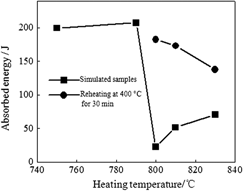Crossref Citations
This article has been cited by the following publications. This list is generated based on data provided by
Crossref.
Wang, Jiantao
and
Sun, Qing
2019.
Cyclic testing of Q690 circular high-strength concrete-filled thin-walled steel tubular columns.
Advances in Structural Engineering,
Vol. 22,
Issue. 2,
p.
444.
Jorge, J.C.F.
Bott, I.S.
Souza, L.F.G.
Mendes, M.C.
Araújo, L.S.
and
Evans, G.M.
2019.
Mechanical and microstructural behavior of C-Mn steel weld deposits with varying titanium contents.
Journal of Materials Research and Technology,
Vol. 8,
Issue. 5,
p.
4659.
Fang, Tao
Liu, Xia
Shao, Chendong
Cui, Haichao
and
Lu, Fenggui
2020.
Role of tempering cooling rate on impact toughness of 2CrMoV weld metal.
Journal of Materials Research,
Vol. 35,
Issue. 12,
p.
1612.
Zhang, Yue
Xiao, Jun
Liu, Wei
and
Zhao, Aimin
2021.
Effect of Welding Peak Temperature on Microstructure and Impact Toughness of Heat-Affected Zone of Q690 High Strength Bridge Steel.
Materials,
Vol. 14,
Issue. 11,
p.
2981.
Carpenter, Kristin R.
Dissanayaka, Pragathi
Sterjovski, Zoran
Li, Huijun
Donato, Joe
Gazder, Azdiar A.
van Duin, Stephen
Miller, Dan
and
Johansson, Mikael
2021.
The effects of multiple repair welds on a quenched and tempered steel for naval vessels.
Welding in the World,
Vol. 65,
Issue. 10,
p.
1997.
Pańcikiewicz, Krzysztof
Filar, Bartosz
and
Smoleń, Bogdan
2022.
Influence of twin-wire welding on the microstructure and properties of structural steel.
Manufacturing Letters,
Vol. 31,
Issue. ,
p.
6.
Du, Yaohan
Liu, Hanqing
Liu, Yongjie
Li, Lang
Wang, Chong
Yang, Yu
Yang, Ying
and
Wang, Qingyuan
2023.
Microstructural inhomogeneity and associated hetero mechanical behavior in advanced bainitic weathering steel weldments.
Journal of Materials Research and Technology,
Vol. 27,
Issue. ,
p.
7167.
Gong, Weiyi
Wang, Xitao
Song, Xiaobin
Wu, Huibin
and
He, Jinshan
2024.
Effect of intercritical annealing on microstructure and impact toughness of ultra-low-carbon steel after welding thermal simulation.
Journal of Materials Research and Technology,
Vol. 29,
Issue. ,
p.
3089.
Qi, Huan
Pang, Qihang
Li, Weijuan
and
Bian, Shouyuan
2024.
The Influence of the Second Phase on the Microstructure Evolution of the Welding Heat-Affected Zone of Q690 Steel with High Heat Input.
Materials,
Vol. 17,
Issue. 3,
p.
613.
Addai, B.
Gyimah, K.O.
Asumadu, T.K.
Anto, M.
Klenam, D.E.P.
and
Soboyejo, W.O.
2024.
Strain gradient plasticity in AISI A36 plain carbon steel weldment: Comparison of butt and lap joint configurations.
Results in Engineering,
Vol. 22,
Issue. ,
p.
102078.
